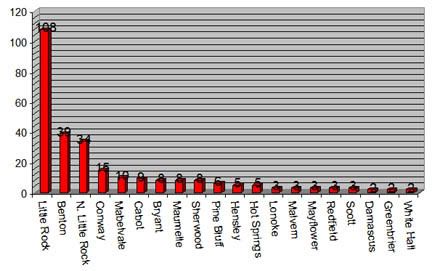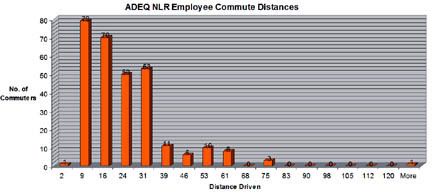As part of ADEQ's ongoing internal environmental management system, we evaluate the agency's potential impact/footprint on the local environment. After some 30 years at our old location near Geyer Springs Road in SW Little Rock, we moved in August 2007 to our new campus in North Little Rock's Northshore industrial park, near the Maumelle exit on I-430. In doing so, we consolidated the staff from six different locations to a single campus. As many employees had settled in communities convenient to the old work site, commute distances changed for many... either longer or shorter. To evaluate the potential impact of this, a table was made showing the address, city, and ZIP code for each current employee, each address was plotted using Google Maps, and the distance of the optimum route from that location to 5301 Northshore Drive, NLR, (as calculated by Google Maps) was calculated and recorded. Subtracting out duplicate addresses, the remainder was summed to determine a total, one-way commute distance.
As of the time of the study (February, 2008) there are 304 employees at the North Little Rock campus. Assuming that employees who share the same address travel together (12 cases), the one-way daily commuting mileage for ADEQ employees is 5,280 miles one way, for a total of 10,560 miles commuted per business day. In rough figures, it's 17.4 miles per employee per day (using the arithmetic mean, (e.g. dividing 10,560 by the number of drivers). The median is 16 miles; the mode is 9 miles.
Assuming an average efficiency of 18 miles per gallon of gas (we have lots of pickup trucks out in the parking lot, including mine), this is roughly equates to the consumption of 587 gallons of gas per day, or $1,853 at the price down at the corner gas station on Maumelle Boulevard ($3.159 as of 7:10 a.m this morning).
In terms of air emissions, this fuel consumption equates to, on a per day basis:
• 11,740 pounds of carbon dioxide (CO2)/greenhouse gases emitted; plus
• 347 pounds of carbon monoxide (CO)
• 46.1 pounds of nitrogen oxides (NOX)
• 41.7 pounds of stray, incompletely combusted hydrocarbons.
ADEQ employees live in 38 different communities as shown below:

In addition to these, at least one employee lives in the communities of Alexander, Bee Branch, Bigelow, Cammack Village, Carlisle, Carthage, Center Ridge, Dardanelle, Edgemont, El Dorado, Hot Springs Village, Jacksonville, Morrilton, Roland, Shannon Hills, Tucker, and Vilonia.
Excel's histogram function was used to group commuters by distance traveled (also one-way):

At a quick glance, the shortest commute is 1.7 miles (one way) by someone who lives just off Crystal Hill Road; the longest commute (not counting our stray guy from El Dorado (127 miles each way)) is 72.7 miles from just north of Greer's Ferry Lake (also one-way). Distances were estimated using the route option on Google Maps; for the dozen or so sites that wouldn't plot, I used the average distance for others in that area.
This just relates to getting to and from work... it doesn't count the impact of those who leave the campus for the noon meal, and does not take into account any intermediate stops along the way, e.g. for shopping or whatever purpose.
(Emissions were calculated using factors from the Colorado PH&E Department (e.g., one gallon of gasoline burned emits 20.35 pounds of CO2; per-mile vehicle emissions are 14.9 grams/mile for CO, 1.98 g/mi for NOx, and 1.79 g/mi for hydrocarbons. Grams were then converted to pounds for the more familiar unit of measure.)
ADEQ's business operations, especially the vehicle fleet, have been tracked over the past three years as one of our environmental indicators. Historically, the performance measures have been 1) amount of gasoline consumed; and 2) transitioning to a more fuel-efficient fleet.
Currently ADEQ has 118 motor vehicles (and 3 bass boats, used for water sample collection and similar needs), 31 of which are based at the NLR offices. Fuel usage is trending down slightly (from 78,182 gallons in 2005 to 75,175 in 2007) and the mileage efficiency has remained about the same... an average of 18.9 in 2005 to the current value, 19.3 mpg. Mileage has not been tracked as an indicator, but dividing 75K gallons by 19.3 mpg for 2007, we roughly got 4,051 miles on the fleet vehicles during the year... less than a single day's commuting impact.
For the record, here’s a figure from the Sept.-Oct. 2007 issue of the League’s magazine, American Bicyclist, that shows how Americans get to work, at least as they claimed in the census survey in March 2000.

Arkansas’s figures are a good bit higher – in the Little Rock metro area, more than 81% drive alone, and less than 1% (well. 0.9%) take public transportation. Housing is pretty plentiful and cheap here. The long running, 50+ year old controversy in the school system has taken its toll as well, as many move to the outlying areas simply to keep their children out of the Little Rock school system.
There’s no quick and easy solution at this point. Naturally, I would suggest cycling to work as a way to help out. My daily commute to the office is 24.7 miles, one way, up a bit from the 21 miles I did to the old office site off Geyer Springs. The distance by bicycle, using the River Trail system, is 23.4 miles, driveway to driveway, but passes through a long stretch of Highway 165 between I-440 and Rose City that is one of the least bike-friendly routes around. Narrow or no shoulders, definitely no bike accommodations, and populated with a host of aggressive drivers who don’t look out much for each other, much less cyclists.
Our public transportation system isn’t much help, either. CATA has made great progress in the past year in the core area of the city, adding bike racks to all the buses. And to their credit, nearly every bus I’ve seen go by in the past couple of months has a bike in the rack. But CAT only has 58 buses in their fleet, and they’re saturated running the routes they currently offer. They run the “Maumelle Express” twice in the morning and three times during the afternoon rush hours.
Light rail has been mentioned as a possible solution to parallel the pending upgrade of I-630. But any progress along those lines is likely years in the future.
And, to sweeten the deal, EPA announced yesterday that they will be lowering the ozone standards from the current level of 85 ppb to 75 ppb. This means that Pulaski County and the LR metro area will likely be declared to be in “non-attainment” in the very near future. Look for folks to be getting a lot more serious about Ozone Action Days this summer…

No comments:
Post a Comment